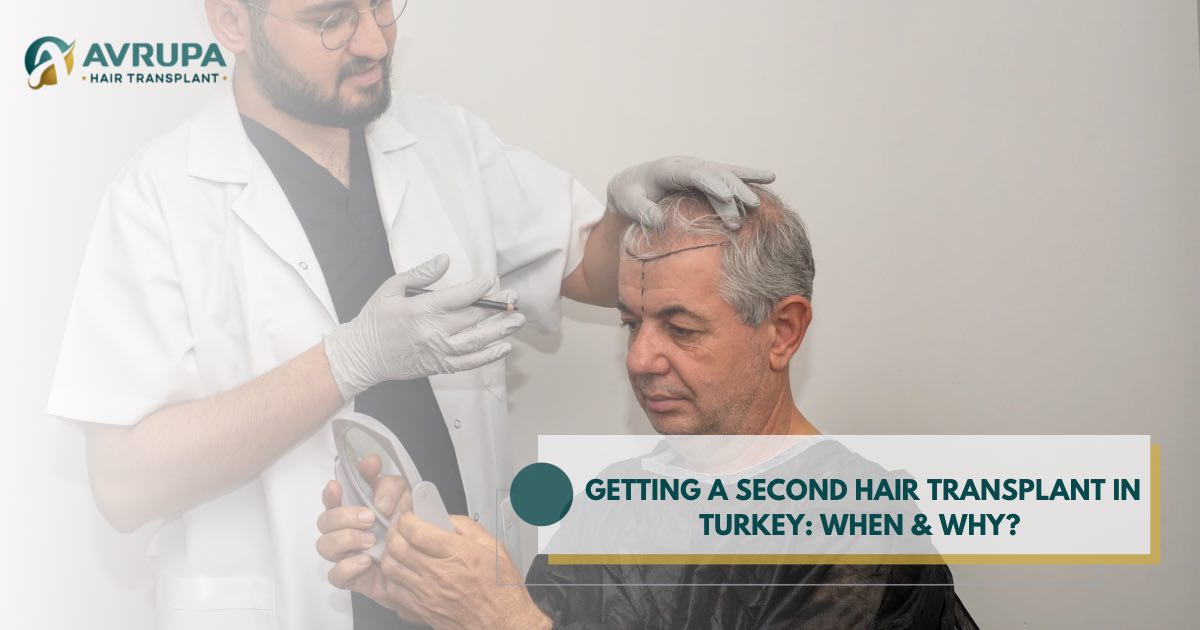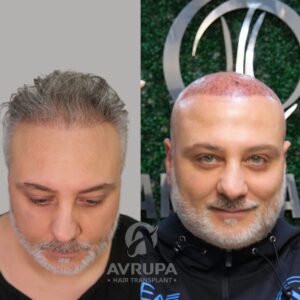
Getting a Second Hair Transplant in Turkey: When and Who’s Eligible?

October 14, 2025 by
avrupahairtransplant
Hair transplantation has given millions of people the opportunity to regain their confidence and achieve a natural-looking hair restoration. However, not every patient achieves their desired density in the first procedure, and others may continue to lose hair as they age. This often leads to a need for a second hair transplant.
Turkey has become the global hub for hair transplants, renowned for its advanced techniques, internationally recognized surgeons, and competitive prices. But when it comes to a second hair transplant in Turkey, there are unique considerations regarding timing, candidacy, donor availability, and realistic outcomes.
This article explains everything patients need to know before booking a second procedure in Turkey — from when it’s recommended, to how results differ from the first surgery, to what makes Turkey the preferred destination.
Why Patients Consider a Second Hair Transplant?
A second hair transplant is more common than many realize. Here are the main reasons why patients seek one:
- Insufficient Density After the First Surgery: Sometimes the initial procedure does not achieve the desired thickness, especially if the hair loss was advanced.
- Progressive Hair Loss: Hair transplantation does not stop natural balding. Patients may experience new thinning in untreated areas, requiring a second procedure.
- Unnatural Results from a Previous Clinic: Poorly performed transplants (often due to unskilled clinics) can leave patients with pluggy, sparse, or uneven hairlines that need correction.
- Scar Coverage: Patients who underwent the older FUT (strip) method may want a second transplant to cover linear scars.
Can a Second Hair Transplant Damage the First?
This is one of the most common concerns. The short answer: not if performed correctly.
- Proper Spacing: Surgeons in Turkey are trained to respect the existing transplanted grafts and place new grafts in between them without damaging earlier work.
- Technique Selection: Methods like DHI (Direct Hair Implantation) allow precise implantation in dense or previously transplanted areas.
- Timing Matters: Performing a second transplant too soon (before 12–18 months) risks disrupting grafts that have not fully matured.
In reputable Turkish clinics, surgeons carefully evaluate the outcome of the first transplant before planning the second, ensuring the new procedure enhances rather than harms the earlier results.
When Is a Second Hair Transplant Recommended?
Surgeons typically recommend waiting at least 6 months after the first procedure or ideally 12 months. This allows:
- Full Hair Growth Cycle: Transplanted hair takes up to a year to fully mature.
- Proper Donor Area Recovery: Overharvesting too soon can lead to permanent thinning of the donor region.
- Stability of Hair Loss: Surgeons assess whether hair loss has stabilized before creating a new long-term plan.
Candidacy for a Second Hair Transplant
Not everyone is a candidate for a second surgery. Surgeons in Turkey evaluate several key factors:
- Donor Hair Availability: The back and sides of the scalp (permanent zones) must still have enough grafts. Donor depletion is the main limiting factor.
- First Surgery Outcome: A second transplant builds on or corrects previous results, so surgeons must review how well the first procedure healed.
- Scalp Condition: Scarring, skin laxity, and vascular supply all affect the feasibility of another transplant.
- Overall Health: As with the first transplant, patients must be in good health with no uncontrolled conditions.
Second Hair Transplant to Add Density
Many patients request a second hair transplant specifically to increase density in areas that appear thin after the first surgery.
- Common targets include the hairline, temples, and frontal zones, where density is most aesthetically significant.
- Technique Advantage: DHI is often preferred because it allows high-density packing with minimal trauma.
- Donor Strategy: Surgeons may use finer single-hair grafts in the front for a natural appearance and thicker grafts in the back for fullness.
Patients should maintain realistic expectations: while density can be significantly improved, the scalp has limited space for grafts, and natural spacing must be preserved to ensure a stable blood supply.
Second Hair Transplant in the Crown
The crown (vertex) is one of the trickiest areas to restore because of:
- Whorl Patterns: Natural spirals require precise angling of grafts.
- High Graft Demand: The crown covers a large surface area, necessitating thousands of grafts to achieve full density.
- Progressive Balding: Crown thinning often continues over time, meaning long-term planning is essential.
In Turkey, surgeons typically recommend treating the crown in a second session, after securing the hairline and frontal zones in the first. This staged approach ensures balanced coverage and prevents the donor area from being exhausted too quickly.
Techniques Used in Second Hair Transplants in Turkey
1. FUE (Follicular Unit Extraction)
The most widely used method in Turkey, FUE is ideal for second transplants since it allows surgeons to carefully extract remaining grafts without leaving a linear scar.
2. DHI (Direct Hair Implantation)
Often chosen for refinement cases such as improving hairline density, DHI offers precision placement of grafts with minimal trauma to the scalp.
3. Scar Revision with SMP
For patients with visible FUT scars, a second transplant can be combined with graft implantation and Scalp Micropigmentation (SMP) for camouflage.
Advantages of Getting a Second Hair Transplant in Turkey
Turkey stands out for several reasons when it comes to repeat hair transplant procedures:
-
Highly Experienced Surgeons: Many Turkish surgeons specialize in repair and second transplant cases.
-
Advanced Donor Management: Clinics are skilled at maximizing graft yield without overharvesting.
-
Cost-Effectiveness: A second transplant in Turkey costs a fraction of what it would in the US or UK, even with additional complexity.
-
Custom Planning: Clinics offer tailored approaches, from density improvements to scar corrections.
Second Hair Transplant Success Rate
The success rate of a second transplant in Turkey depends on donor availability, surgeon expertise, and patient compliance with aftercare.
- Average Success Rate: 85–95% graft survival in leading Turkish clinics.
- Repair Cases: Slightly lower survival if grafts are placed in scar tissue or previously transplanted areas.
- Density Improvement: Most patients achieve noticeable improvement, but full density may not always be possible.
- Long-Term Satisfaction: High, when realistic expectations are set and the patient follows medical advice.
Compared to first transplants, the success rate is only slightly lower; however, proper clinic selection makes all the difference.
Risks and Challenges of a Second Hair Transplant
While second procedures can be highly successful, patients should be aware of certain limitations:
- Donor Exhaustion: If the donor area is weak, results may be limited.
- Reduced Graft Survival Rate: Scar tissue may lower graft survival compared to virgin scalp.
- Unrealistic Expectations: Patients must understand that density will improve, but a full head of thick hair may not be possible.
- Scalp Trauma: Previous surgery can make the scalp more delicate.
Costs of a Second Hair Transplant in Turkey
The cost of a second transplant in Turkey is usually slightly lower for older clients. However, in some complex cases, such as scar removal or repairing a botched surgery, the cost may be slightly higher than the initial procedure.
- Average Cost: $2,500 – $5,500
- Compared Globally: The same surgery in the USA can range from $8,000 – $15,000.
- Factors Affecting Price: Number of grafts required, complexity, technique used (FUE vs DHI), and clinic reputation.
Preparing for a Second Hair Transplant in Turkey
Before scheduling, patients should:
- Provide Records of the First Surgery: Photos, graft counts, and technique details help surgeons plan effectively.
- Undergo a New Medical Evaluation: To ensure healing capacity and donor health.
- Set Realistic Goals: Discuss achievable density and coverage with the surgeon.
- Plan Adequate Recovery Time: Just like the first transplant, downtime is required for healing.
Recovery and Results After a Second Hair Transplant
Recovery is similar to the first procedure but may require extra care due to scar tissue.
- Healing Time: Most patients recover within 7–10 days.
- Shedding Phase: Newly implanted hairs may shed before regrowing, just as they do in the first transplant.
- Final Results: Typically, visible within 12 months, with density improvements and corrected hairlines.
Second Hair Transplant Before and After
Below is one of our patients who came for a second hair transplant to repair and refine an old hairline that was previously done elsewhere.

Choosing the Right Clinic in Turkey for a Second Hair Transplant
Not all clinics are equally equipped for complex cases. Patients should look for:
- Proven experience in repair cases
- Transparency about donor limits
- Portfolio of before-and-after photos
- International hygiene and safety standards
Thinking about a Second Procedure?
Our experienced team at Avrupa Hair Transplant Clinic specializes in second hair transplant procedures, helping patients improve density, repair scars, and achieve natural results with full safety and care.
Bottom Line
A second hair transplant in Turkey can be life-changing for patients who were left unsatisfied with their first procedure or who experienced continued hair loss or simply want to increase hair density. With expert surgeons, advanced techniques, and affordable pricing, Turkey remains the top choice for both first-time and repeat patients.
FAQs
Is it worthwhile to undergo a second hair transplant?
Yes, a second hair transplant is worth it if you have sufficient donor hair and realistic expectations. It can improve density, cover thinning areas, or correct poor results, delivering natural, long-lasting improvements with the expertise of Turkish surgeons.
Can a hair transplant be done a second time?
Yes, a hair transplant can be done a second time. Most patients undergo another procedure 6–12 months after the initial one, once growth is complete and the donor area has fully healed. Skilled Turkish clinics ensure safety, protect existing grafts, and maximize density with modern FUE or DHI techniques.
How common is a second hair transplant?
Second hair transplants are quite common, especially among patients with advanced baldness or progressive hair loss. Many also seek them for density enhancement or repair work. In Turkey, experienced surgeons regularly perform second procedures with high success rates and patient satisfaction.
How long to wait for the second hair transplant?
Patients should usually wait at least 6–12 months before a second hair transplant. This allows full growth from the first surgery, ensures donor area recovery, and helps surgeons plan density and coverage more effectively for natural, lasting results.
Written By
avrupahairtransplant
Avrupa Hair Transplant Clinic, Istanbul’s trusted name since 2006, transforms hair restoration with cutting-edge techniques like FUE, DHI, and Sapphire, crafting natural, lasting results. With over 40,000 success stories and a collection of international awards, Avrupa blends innovation with artistry, delivering personalized care that redefines confidence for clients worldwide.